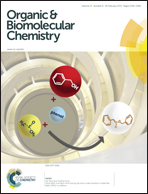LNA units present in the (2′-OMe)-RNA strand stabilize parallel duplexes (2′-OMe)-RNA/[All-RP-PS]-DNA and parallel triplexes (2′-OMe)-RNA/[All-RP-PS]-DNA/RNA. An improved tool for the inhibition of reverse transcription†‡
Abstract
Homopurine phosphorothioate analogs of DNA, possessing all phosphorus atoms of RP configuration ([All-RP-PS]-DNA), when interact with appropriate complementary RNA or (2′-OMe)-RNA templates, form parallel triplexes or parallel duplexes of very high thermodynamic stability. The present results show that T-LNA or 5-Me-C-LNA units introduced into the parallel Hoogsteen-paired (2′-OMe)-RNA strands (up to four units in the oligomers of 9 or 12 nt in length) stabilize these parallel complexes. At neutral pH, dodecameric parallel duplexes have Tm values of 62–68 °C, which are by 4–10 °C higher than Tm for the reference duplex (with no LNA units present), while for the corresponding triplexes, Tm values exceeded 85 °C. For nonameric parallel duplexes, melting temperatures of 38–62 °C were found and (2′-OMe)-RNA oligomers containing 5-Me-C-LNA units stabilized the complexes more efficiently than the T-LNA containing congeners. In both series the stability of the parallel complexes increased with an increasing number of LNA units present. The same trend was observed in experiments of reverse transcription RNA→DNA (using AMV RT reverse transcriptase) where the formation of parallel triplexes (consisting of an RNA template, [All-RP-PS]-DNA nonamer and Hoogsteen-paired (2′-OMe)-RNA strands containing the LNA units) led to the efficient inhibition of the process. Under the best conditions checked (four 5-Me-C-LNA units, three-fold excess over the RNA template) the inhibition was 94% effective, compared to 71% inhibition observed in the reference system with the Hoogsteen-paired (2′-OMe)-RNA strand carrying no LNA units. This kind of complexation may “arrest” harmful RNA oligomers (e.g., viral RNA or mRNA of unwanted proteins) and, beneficially, exclude them from enzymatic processes, otherwise leading to viral or genetic diseases.
![Graphical abstract: LNA units present in the (2′-OMe)-RNA strand stabilize parallel duplexes (2′-OMe)-RNA/[All-RP-PS]-DNA and parallel triplexes (2′-OMe)-RNA/[All-RP-PS]-DNA/RNA. An improved tool for the inhibition of reverse transcription](/en/Image/Get?imageInfo.ImageType=GA&imageInfo.ImageIdentifier.ManuscriptID=C4OB02364A&imageInfo.ImageIdentifier.Year=2015)

 Please wait while we load your content...
Please wait while we load your content...